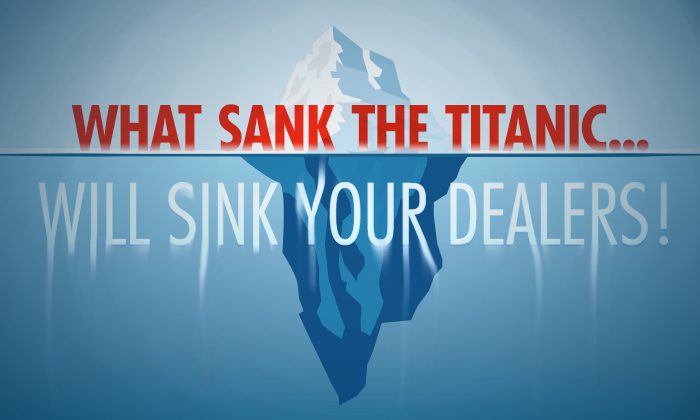What Sank the Titanic Will Sink Your Dealers!
“Iceberg, right ahead!” is the shout Fred Fleet, the lookout for the ill-fated Titanic, is said to have given when he saw the ship’s doom ahead. How could the Titanic, such a large and well-designed ship, ever sink? History tells us numerous factors may have led to its sinking. The F&I office has become a much larger “ship” in the overall profit of every dealership. Using factors that sunk the Titanic comparatively can sound alarms for the F&I offices we work in. Responding to the alarms might help avoid a catastrophic F&I failure! Let’s look at a few.
An iceberg sank the Titanic, but it wasn’t the only factor. Learn how to prevent the F&I office you train from sharing the doomed ship’s fate.
1. An Opportunity Was Missed.
Before Titanic left the English port at Southampton, a smoldering fire broke out in the ship’s coal bunker boiler rooms and weakened the ship’s structure, making the iceberg crash more devastating than it could have been otherwise. A consistent inspection of the ship could have avoided catastrophe.
Tracking every indicator of F&I performance consistently, including production numbers, CSI scores, training activity, and product income vs. reserve income can alert us early to potential problems that can be corrected before they become a threat to sink the ship!
2. Warnings Were Ignored.
Captain Edward Smith felt the warning concerning icebergs was not urgent because it lacked a certain prefix that identified it as such.
Low CSI scores can be an indicator of too much pressure in the F&I process. Low commitment levels to training activity can indicate someone has stopped learning and that will eventually sink a ship in the ever-changing waters of F&I!
3. Confusion Cost Precious Seconds.
The ocean liner was operating with two communication systems that were in direct conflict with each other. The command for a sharp turn of the ship eventually came across as the opposite direction they needed to go in order to avoid the iceberg.
The F&I office, sales manager and general manager must all be operating under clear instructions of how to handle the buying process. As we say in the south, we all need to be singing from the same hymnal.
4. The Structure Was Weak.
Material scientists have claimed the pieces holding together the steel plates of the joints of the ship were made of low-quality iron rivets that could have broken more easily upon collision.
What builds a great F&I team? Like any sports team, it boils down to a great game plan, training to prepare for the big game, and holding them accountable for results. Does every manager you work with have a plan for how they are going to reach their goals? Is training consistent and tracked? If the results are lower than expected, make sure proper materials are used to avoid a crash.
5. There Was a Shortage of Binoculars and Lifeboats.
The person with the key to the locker where binoculars were stored was bumped from the crew at the last minute. Binoculars may have enabled them to see the danger earlier. The 20 lifeboats onboard were only half as many needed for the 1,718 passengers, and only 700 passengers survived. The lack of proper tools led to disaster.
The most important tool in the F&I office is a customer-focused, needs-based approach to building value in our products. Utilizing an interactive and visual effort with today’s customer is critical for success.
As independent agents, we can help assure our partners have everything they need to succeed. We can track effort and production, facilitate good communication between departments, help develop a game plan, and provide the tools that will lead to success. … and hopefully avoid the icebergs!
Find more great resources & articles here.
This blog article was also published on Agent Entrepreneur.

